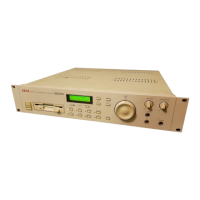PROGRAM EDIT
S2000 Operator’s Manual - Version 1.30 Page 107
potential distortion) as a result of high resonance settings. As usual, the parameters are
selected using F1 and F2 and the values are set using the DATA wheel. Use the outer
SELECT wheel to select the keygroup you wish to affect.
The next page down shows these parameters:
Here, you may set the selected filter type’s cutoff frequency and resonance. The parameters
are selected using F1 and F2 and values are set using the DATA wheel. Use the outer select
wheel to select the keygroup you want to affect.
NOTE: The resonance control functions differently when EQ is selected. When EQ is
selected, a value of 16 is no cut or boost. Raising the resonance above 16 will boost the
selected cutoff frequency and lowering it below 16 will cut the selected cutoff frequency. You
will, therefore, experience a tonal change when you switch from LP, BP or HP to EQ in the
previous page. For example, if a value of 16 is set for the resonance on the other three filters,
this will be flat when you select EQ. Similarly, if a value of 0 is set on the other three filters, this
will cause the cutoff frequency to be cut when you select EQ.
The next page down is as follows:
In this page, you can set keyboard tracking. The KBD parameter allows you to set the keyboard
to track the second filter. This is so that you can achieve an even tone across the keyboard
range. +12 tracks the filter octave for octave - i.e. for every shift of pitch of one octave, there is
an according shift in harmonics. To adjust keyboard tracking of the filter, use the DATA wheel
to set the value.
The next few pages deal with the second filter’s modulation inputs. The first is:
VELO(ity) allows you to control the cutoff frequency using velocity. In this way, you can use the
filter to mimic ‘real life’ where playing an instrument harder will normally give a brighter sound.
By setting a positive velocity value here, the sound will be brighter the harder you hit the key.
The next page down shows this screen:
LFO2 may be used for filter sweep effects such as flute tremolando or dramatic, resonant synth
effects.
The third modulation input is on the next page down:
the default selection for this modulation input is the third envelope generator that is available
with the IB304F.

